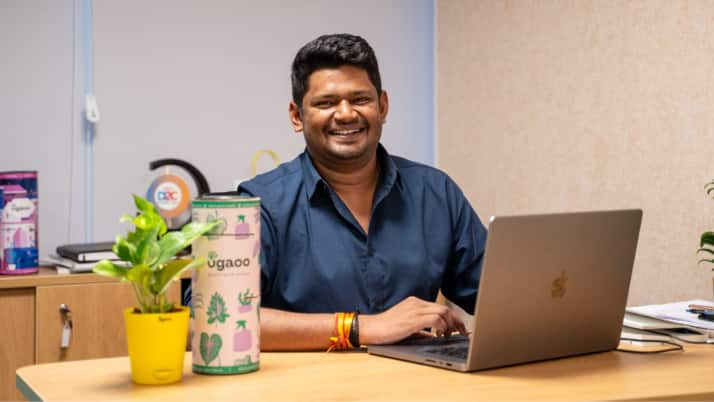By blending education, innovation, and design, Ugaoo has turned millennials and Gen Z into passionate plant owners, transforming gardening from a niche hobby into a lifestyle trend.

Siddhanth Bhalinge, Founder and CEO, Ugaoo. (Source: prhandout)
You may have scrolled past its signature self-watering pots on quick commerce apps or seen its vibrant greens brightening urban homes across social media. Recently, Ugaoo made headlines by appointing Jackie Shroff—an actor celebrated for his love of plants and relatable charm across generations—as its first brand ambassador. In less than a decade, the brand has grown from an online gardening startup to one of India’s most recognisable names, turning greenery into a lifestyle choice for millennials and Gen Z.
When it launched in 2015-16, plant buying in India was largely offline, unorganised, and intimidating for first-timers. Ugaoo tackled this with beginner-friendly species, easy-care innovations like slow-release soil and Made in India self-watering pots, and a heavy focus on plant education. The approach paid off. Today, the Rs. 249 Jade plant is its most popular gift, with small plants making up 60% of sales.
In a conversation with FE BrandWagon, Siddhanth Bhalinge, Founder & CEO of Ugaoo, shares how the company now sells 2.5–3 lakh plants a month from its 25-acre farm, operates 11 stores across three metros, and is eyeing Rs. 155 crore topline this year. The next phase of growth will see it enter Tier 2 and Tier 3 cities via a franchise model, aiming for 100 stores by 2030 and a spot as the “Colgate” of plants in India. (Edited Excerpts)
Ugaoo started its journey around 2015–16, a time when gardening in India was still largely seen as a niche hobby for a small segment of consumers. Walk us through the early marketing bets you made to expand its appeal beyond hobbyists, connect with new types of customers, and also define exactly who your target audience has been since the beginning.
Since inception, we have primarily targeted millennials and, later, Gen Z, as they were the most open to new lifestyle trends and, at the time, only millennials had significant buying power. The biggest gap we identified in the market was the lack of awareness—most people didn’t know how to care for plants or choose the right ones for their spaces, and credible information was scarce. In our first three years, we invested heavily in educational content to guide people through their plant journey—starting with easy indoor plants, recommending the first three to begin with, and gradually introducing more challenging varieties. Another key focus was making plant care simpler to encourage ownership. Many had a “plant phobia,” fearing they would kill the plant and waste their money. We addressed this with value-added innovations such as Made in India self-watering pots and a slow-release soil mix that required no fertilisation for the first six months. This ease of care built confidence, leading customers to buy more and discover that plants offer not just aesthetic beauty, but also emotional and wellness benefits, creating more balanced and fulfilling living spaces.
You recently appointed Jackie Shroff as Ugaoo’s first-ever brand ambassador—a rare move in this category. What was the thinking behind choosing him, and how do you see this partnership impacting your brand reach?
We wanted to reach a broader audience. Our digital-first approach through Meta and Google primarily targeted digitally-savvy consumers. Jackie Shroff’s popularity cuts across generations—from people in their 50s and 60s to Gen Z—thanks to his relatable personality and strong presence on social media.
Ugaoo’s values—spreading greenery and encouraging plant gifting—aligned naturally with his persona. He is known for his generosity, passion for plantation drives, and support for environmental causes, often without monetary motivation. His popularity in Tier 2 and Tier 3 cities will help us improve brand recall where we are less established.
Frankly, we would have either chosen Jackie or no brand ambassador at all. The fit felt authentic.
When it comes to your marketing strategy, how do you balance sticking to tried-and-tested channels with exploring newer platforms, formats, or even emerging technologies?
Initially, we relied solely on Google and Meta. With this campaign, we are branching out into OTT platforms like Disney+ Hotstar and MX Player, cinema advertising, and airport digital signage. We’re also exploring prime-location outdoor hoardings.
These are channels we haven’t tried before, but we believe they align with our audience’s presence and will enhance brand visibility.
In your experience, how important is price in this decision-making process, and what patterns do you see in the sizes and products that sell the most?
Yes, price plays a significant role, often depending on where someone is in their plant journey. For beginners, the comfort range is Rs. 199–Rs. 299, with our bestseller being the Rs. 249 Jade plant—our most gifted and highest-volume product. As customers progress, they tend to explore exotic plants priced between Rs. 499–Rs. 999, and eventually larger accent plants for homes or workplaces in the Rs. 2,000–Rs. 3,000 range. In terms of size mix, small plants dominate with about 60% of sales, medium sizes make up 20%, and large plus XL plants together account for the remaining 20%.
With the rapid growth of e-commerce and the rise of quick commerce, many D2C brands are rethinking their approach—whether to remain digital-first or to expand into a truly omnichannel presence. How has Ugaoo approached this shift, and what does your current distribution mix look like across various channels?
We operate through four primary channels: our website, retail stores, quick commerce, and online marketplaces. Each has its use case. Broadly, purchases fall into two categories—self-use and gifting.
Quick commerce is predominantly gifting, as plants are a universal present suitable for any gender, age, or occasion. For self-use, customers prefer our website or retail stores, where the variety is far greater—around 1,200 SKUs, compared to just 25–30 SKUs on quick commerce.
Marketplaces attract entry-level customers experimenting with plant care. After a couple of purchases on Amazon or Flipkart, many move to our website or retail stores for a greater variety.
In revenue terms, marketplaces (especially Amazon) are number one, followed by quick commerce for gifting. Our channels—website and retail—together make up around 40% of revenue, quick commerce about 30%, and physical stores plus website about 20%.
Some D2C founders say their brand websites underperform compared to marketplaces, while others see them as the strongest revenue channel. In your case, why do you think your website contributes less revenue than other platforms?
Our primary audience—millennials and Gen Z—spend more time on marketplaces, where they also make impulse purchases. With increased platform visibility, they buy plants there rather than specifically visiting our site.
In earlier years, this might have been a bigger issue, but today’s consumers are less concerned about where they purchase from, as long as they get the brand they want.
How many stores do you operate right now, and what is your strategy for expanding into new markets, including Tier 2 and Tier 3 cities?
We currently have 11 stores—four each in Mumbai and Pune, and three in Bangalore. Our immediate goal is to expand across metros, adding stores in Hyderabad, Delhi, and eventually Kolkata.
For Tier 2 and Tier 3 cities, we will adopt a franchise model starting next year, targeting high-potential markets like Indore and Lucknow. Local partners will manage operations, while we provide store design and supply products directly from our farm.
Throw light on the scale of your farming and production facilities, your supply chain, and the size of your team?
Our 25-acre farm in Talegaon grows 2.5–3 lakh plants each month. We also manufacture our fertilisers, select planters, and gardening tools.
We have regional hubs in Delhi, Pune, Mumbai, Bangalore, and Hyderabad—each about one acre with polyhouses and warehouse facilities. Plants are grown at the main farm, distributed to these hubs, and then shipped to regional customers.
Our team comprises about 200 executives and 300 farm/packing workers, making a total of over 500 people. Retail-wise, we have 11 stores currently, with plans to expand within our existing metro cities before entering new ones.
Financially, we are operationally break-even. Last year, we achieved Rs. 95 crore in topline revenue with an EBITDA of –2%. This year, we’re targeting Rs. 155 crore with 1–2% positive EBITDA. By 2030, we aim to have 100 stores.
Going ahead, how do you want Ugaoo to be perceived beyond simply being India’s go-to gardening brand?
The gardening category in India is still highly unorganised. Our goal is to become the “Xerox” or “Colgate” of plants—so synonymous with the category that when people think of plants, they think of Ugaoo.
Unlike smaller competitors who operate as traders, we grow our plants, ensuring better quality, longer life, and easier maintenance. We continuously innovate products that solve real problems in the gardening journey, rather than just releasing aesthetic collections.
Our focus is on fair pricing and adding value. With our integrated supply chain, deep expertise, and growing brand presence, we believe we’re well ahead—and we intend to stay there through innovation and consumer trust.
By continuing you agree to our Privacy Policy & Terms & Conditions
